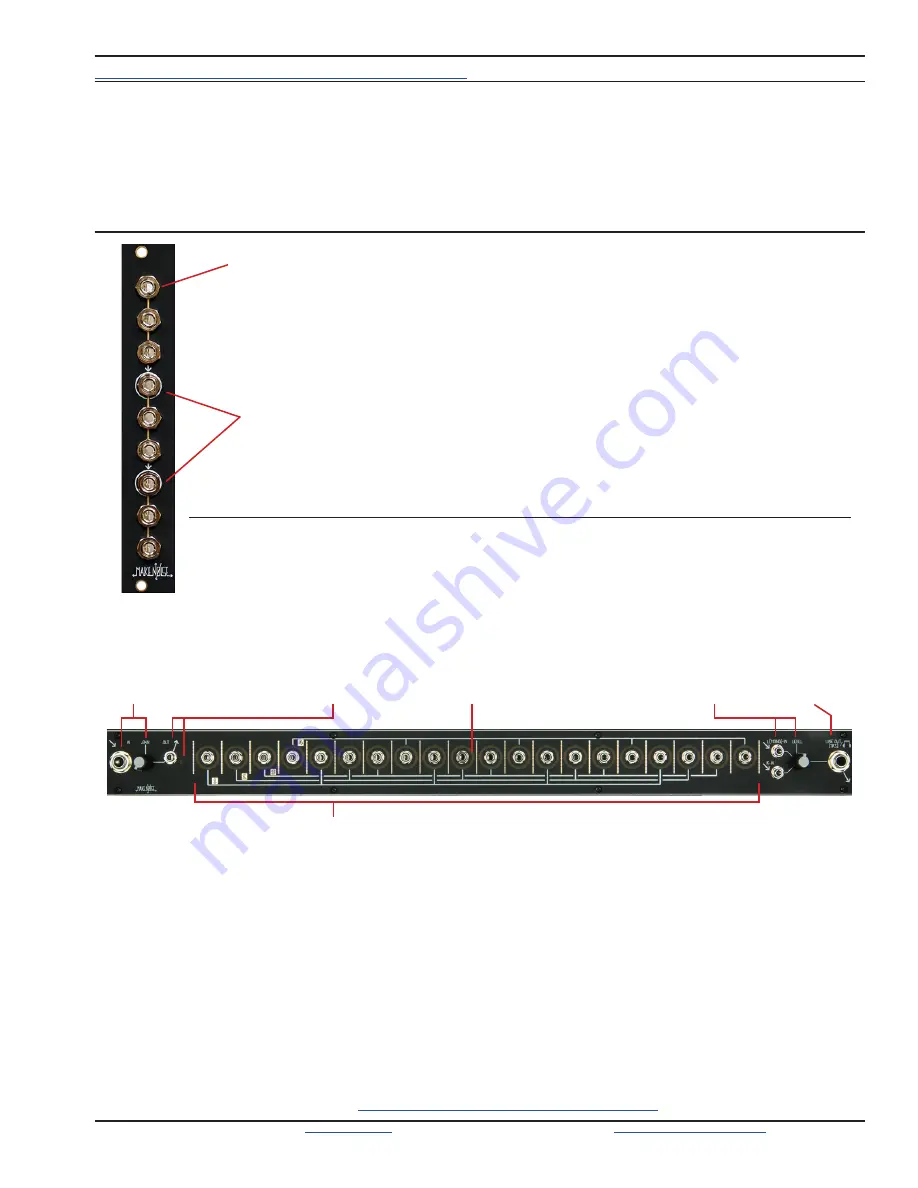
©2015 - Compiled by Robert Anselmi
for full manual
Make Noise Passive Multiple & CV Bus
Utility Modules
The
Passive Multiple
is a simple but important module that allows for sending a signal to multiple destinations. Within the Make Noise system the Multiple may
also be used for combining clock, gate and pulse signals together to create interesting timing sources (in other words, it acts as a Gate combiner aka logic OR
circuit). It has 9 inter-connected sockets that may be split into different group combinations depending upon how it is patched. The jacks circled in white will
make or break the interconnects between the 3 groups of three, thus allowing for three 3-way, one 5-way / one 3-way or one 7-way multiple. The Multiple is pas-
sive. The Make Noise system does not require Buffered Multiples since all critical control signals are already buffered.
The
CV Bus
provides visual indication of level, rate and polarity for up to 4 color-coded control signals that will be shared throughout a patch. They are distribut-
ed across the center of the system allowing for quick, clean and intuitive patching. The visual indication makes navigating complex patches easier and intuitive.
The CV Bus also has the tools needed for integrating the Make Noise system with the outside world. A 1/4” Mono input with plenty of gain allows for bringing
external signals into the system. The optimal 10Vpp signal level is visually indicated. A high quality Stereo Line Driver converts powerful modular synthesizer
signal levels to the commonly used Line Level. There is mini-jack inputs for Left and Right, a single Master Volume control, and a TRS Stereo 1/4” output jack.
This output is capable of driving long cable out to a PA System or a set of Headphones. It has AC coupling and a built-in limiting circuit (with visual indication).
INPUTS & OUTPUTS:
Each jack can operate as an input or an output, except the white-circled jacks, which are “input only.”
Patching into one input creates a split of that input into all other jacks, which can then operate as outputs, where the input signal can
be tapped. A few other notes:
●
You can input a signal into any one of the 9 jacks. The output is tapped from any of the other jacks.
●
You can split any kind of signal: audio, CV, or gates.
●
You can also mix (combine) clock, gate and pulse signals (OR logic). You cannot mix audio or other CV signals. Combination
of Audio / other CV signals is not supported, but will not damage anything.
●
The only time a buffered multiple is needed is when control voltage is sent from an unbuffered output to multiple destinations
that require unity at the input; typically, 1v/oct inputs. Because all critical CV outputs in the Make Noise System are buffered, a
passive multiple is all that is needed.
●
White-circled jacks make or break connections within the Multiple. While all other jacks are normalled, meaning, they split the
signal to all other outputs, the white-circled jacks are “input only,” and are not used as outputs. In this way, you can create
various multiple combinations: three 3-way, one 5-way & one 3-way, or one 7-way multiple. From a practical standpoint, here’s
what that means:
■
3x (1 input / 2 outputs)
■
1x (1 input / 4 outputs) and 1x (1 input / 2 outputs)
■
1x (1 input / 6 outputs)
INPUTS & OUTPUTS:
As with the standard Multiple, each jack can operate as an input or an output. However, there are no “input only” jacks, and jacks are
not “normalled” along the entiere bus. Instead, there are four distinct busses. This means that you can patch an input anywhere on the system to produce four
corresponding output splits. The lines on the faceplate denote the four busses.
●
You can input a signal into any one of the 20 jacks. The outputs are then tapped from the four jacks associated to the input (noted by the lines on the
faceplate). In order to create additional splits of a single input, patch from one of the split outputs into a second bus line. For example, if you input a signal
on the first jack (at the left), Bus 1 outputs 4 signals via the Bus one output jacks. Take on of those outputs and patch into the second jack (from the left) to
create an additional set of 4 output splits. Bus 1 now has 3 outputs (the fourth being sent into Bust 2 input), and Bus 2 has 4 outputs (for a total of 7 splits
of the one input signal). The CV Bus is a 4 input / 16 output multiple.
●
You can split any kind of signal: audio, CV, or gates.
●
You can also mix (combine) clock, gate and pulse signals (OR logic). You cannot mix audio or other CV signals. Combination of Audio / other CV signals
is not supported, but will not damage anything.
●
The only time a buffered multiple is needed is when control voltage is sent from an unbuffered output to multiple destinations that require unity at the input;
typically, 1v/oct inputs. Because all critical CV outputs in the Make Noise System are buffered, a passive multiple is all that is needed.
●
Here are some of the combinations that can be created with the CV Bus:
■
4x (1 input / 4 outputs)
■
2x (1 input / 7 outputs) --
note: 1 split output is sent into a second bus input.
■
1x (1 input / 10 outputs) --
note: 2 split outputs are sent into second and third bus inputs.
and 1x (1 input / 4 outputs)
■
1x (1 input / 13 outputs) --
note: 3 split outputs are sent into second, third, and fourth bus inputs.
For an informative video about the CV Bus, see here:
Make Noise System Tutorial 3: Control Voltage (CV) and Polarity
INPUT
& GAIN
ROTARY:
1/4 inch audio
input jack
for outside
sources to be brought into the
modular system. Since line levels
are lower than modular levels,
there is a unipolar
Gain Rotary
to
increase the amplitude of the audio
input signal.
OUTPUT & LED CLIP
INDICATOR:
After the
audio signal / gain path, you
can use this 1/8 inch jack
to output the audio to any
destination in your modular
system. The
LED Clip
Indicator
will show as a red
exclammation mark if the
level is too hot / volume too
high. If this happens, ease
back on the Gain Rotary.
IN/OUT LEVEL, RATE, POLARITY & COL-
OR CODING:
Surrounding each Input & output
jack is an LED. This indicates the following:
Level
is indicated by the brightness of the LED. Brighter =
higher level, duller = lower level.
Rate
is indicated
by the pulse of the LED.
Polarity
is indicated by
position of the LED. Positive = upper circle half lit,
negative = lower circle half lit.
Color
indicates the
different busses on the system. Green is bus 1, red
is bus 2, yellow is bus 3, and orange is bus 4. The
colors are a great visual indicator, so that you can
see which signals are being output on each bus.
L (MONO) & R
INPUT & LEV-
EL ROTARY:
This is the mono
/ stereo audio
output from the
modular system.
The associated
unipolar
Level
Rotary
allows
you to adjust the
output volume.
LINE OUT
(TRS):
1/4
inch Stereo
TRS audio
jack that can
be used to
send the final
modular output
to headphones,
PA system,
or DAW for
recording.
PASSIVE MULTIPLE
CV BUS (available as part of the
Shared System with CV Bus
and
Black & Gold Shared System
)






























